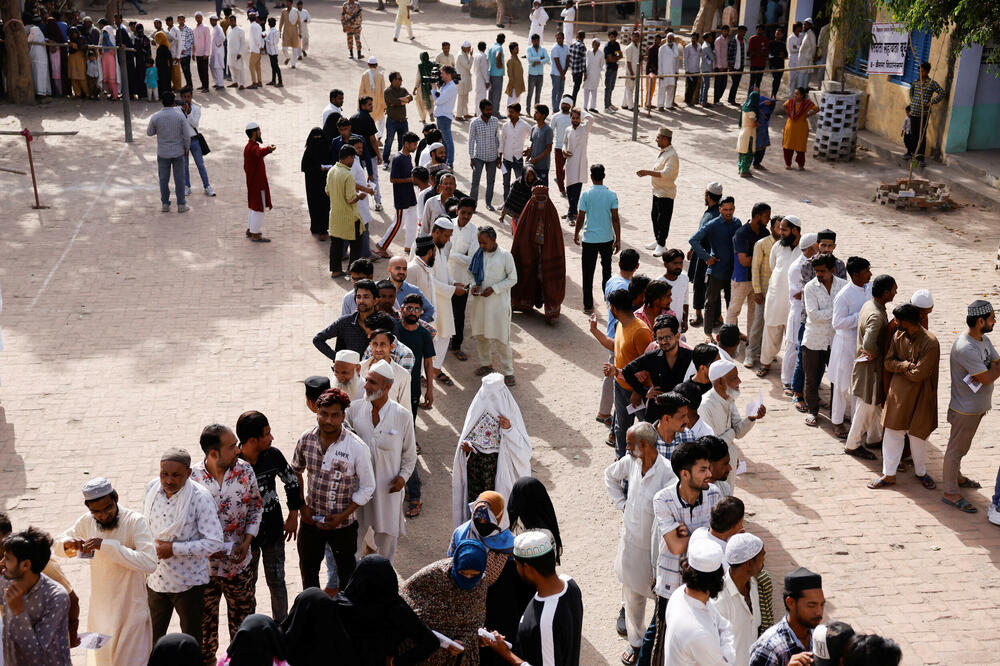The biggest election in the world begins today in India. About 970 million registered voters with the right to vote are participating in this huge process, which will take place in seven stages and last as long as six weeks.
The Prime Minister, Narendra Modi, is hoping to win a third consecutive term. Voters don't actually elect him directly, but the 543 members of the Lok Sabha, the lower house of the Indian parliament.
Six national parties, 57 so-called state parties and 2.597 smaller parties that are allowed to vote, but they do not meet the conditions to be officially recognized by the National Election Commission.
However, the main race will be between India's two largest political parties: the ruling Indian People's Party (BJP) and the opposition Indian National Congress (INC) or Congress Party for short.
In order to oppose the ruling BJP and Prime Minister Modi, the Congress party formed an alliance of 28 parties under the name Indian National Developmental Inclusive Alliance - Indian National Developmental Inclusive Alliance or INDIA.
Modi and BJP are still popular
According to opinion polls, Prime Minister Modi and his Hindu-nationalist BJP are expected to win this year's elections.
Modi is a popular leader, thanks in part to an agenda geared toward India's Hindu majority, which makes up 80 percent of the population. Modi also implemented various programs to boost economic growth and promised to make India the world's third largest economy by 2029.
In the 2019 elections, the BJP won convincingly by winning 303 seats and then formed a coalition that has a total of 353 seats. The Congress party then won 52 seats, and with its coalition allies it won an additional 91.
Modi's BJP has been in power for a decade, with good prospects of securing another five years, but critics accuse it of extinguishing India's decades-long commitment to multiparty democracy and secularism.
Since the BJP won again in 2019, tensions between Hindus and the Muslim minority have escalated.
The BJP's constant reliance on an aggressive Hindu-nationalist agenda has so far been effective in securing votes, but the party's political opponents argue that its ultra-nationalist rhetoric is displacing secularism as the foundation of India's constitution.
Sjeda Hamed, a women's rights activist and former member of India's Planning Commission, fears that the Constitution could be changed if the BJP wins another general election. "It has been openly said that India will become a theocratic state if they (BJP) have a sufficient majority to change the Constitution," Hamed told DW and added. "It is a very real fear that the Constitution could be changed, and the complete climate of oppression could further worsen".
The opposition accuses the BJP government of democratic backsliding, and during the election campaign raised issues related to unemployment and inflation.
The largest electorate in the world
According to official data, India has 497 million men and 471 million women. The electorate has grown by six percent since the 2019 general election.
More than 20 million young voters aged 18 to 29 were added to the electoral roll. "A different trend can be observed among young people, it is interesting that they don't vote so much for parties, but for leaders," BJP politician Narasimha Rao told DW. "It seems that the image of the leader or the candidate is more important for them than for the older ones".
Turnout is always quite high in India. According to data from the election commission, 2019 percent of voters voted in 66.
How do elections work?
India conducts general elections every five years. This year's elections elect the 18th Lok Sabha, the Lower House of Parliament. The country's first post-independence elections were held from October 1951 to February 1952.
The entire process is overseen by the Election Commission of India (ECI), which deploys observers to ensure transparency during the six weeks of voting.
During the six election weeks, voting takes place by region, which determines the ECI based on factors such as the state's population, but also political factors such as potential riots or security concerns.
Voting in the final phase will take place on June 1, and all ballots will be counted on June 4. The results will be published on the same day. To have a majority, a party or coalition must have 272 seats in parliament.
Voting by region allows election commission officials, observers and people in charge of election security to travel from one region to another to ensure that there is no abuse.
The commission also established a code of conduct, which is a set of guidelines for the conduct of political parties and candidates during elections. In case of violation of the rules, penalties are effectively implemented.
The main purpose of the code is to ensure that ruling parties do not abuse their position to gain an unfair advantage. The rules are also designed to prevent corruption.
Almost 340.000 members of the security forces from the ranks of the central police units have been deployed to assist the existing state police forces. They will be transported by trains from one location to another.
Ahead of the vote, India's chief election commissioner, Rajiv Kumar, appealed to political parties to remain civil, especially when it comes to hate speech and misinformation that has surfaced during the campaign.
"I appeal to the parties to maintain decency and refrain from insults and personal attacks," said Kumar.
Billions in campaign costs
The election rules state that the polling station must be the furthest two kilometers from each house. This year, citizens will vote at more than 1,25 million polling stations on 5,5 million Electronic Voting Machines (EVMs) installed in 28 Indian states and nine union territories.
India has been using secure voting machines since 1999. In 2014, printers were also introduced and a printed copy of each ballot is kept in sealed boxes. This is called a "verifiable paper audit trail" and is an additional element of security.
In the 2019 elections, political parties and candidates spent 8,7 billion dollars. This time the sum is higher. According to the Center for Media Studies from New Delhi, political parties and candidates will spend more than 14,4 billion dollars for the elections.
Bonus video:










